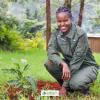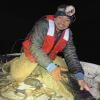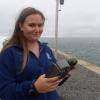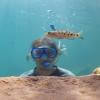With new technologies revolutionizing data collection, wildlife researchers are becoming increasingly able to collect data at much higher volumes than ever before. Now we are facing the challenges of putting this information to use, bringing the science of big data into the conservation arena. With the help of machine learning tools, this area holds immense potential for conservation practices. The applications range from online trafficking alerts to species-specific early warning systems to efficient movement and biodiversity monitoring and beyond.
However, the process of building effective machine learning tools depends upon large amounts of standardized training data, and conservationists currently lack an established system for standardization. How to best develop such a system and incentivize data sharing are questions at the forefront of this work. There are currently multiple AI-based conservation initiatives, including Wildlife Insights and WildBook, that are pioneering applications on this front.
This group is the perfect place to ask all your AI-related questions, no matter your skill level or previous familiarity! You'll find resources, meet other members with similar questions and experts who can answer them, and engage in exciting collaborative opportunities together.
Just getting started with AI in conservation? Check out our introduction tutorial, How Do I Train My First Machine Learning Model? with Daniel Situnayake, and our Virtual Meetup on Big Data. If you're coming from the more technical side of AI/ML, Sara Beery runs an AI for Conservation slack channel that might be of interest. Message her for an invite.
Header Image: Dr Claire Burke / @CBurkeSci

Explore the Basics: AI
Understanding the possibilities for incorporating new technology into your work can feel overwhelming. With so many tools available, so many resources to keep up with, and so many innovative projects happening around the world and in our community, it's easy to lose sight of how and why these new technologies matter, and how they can be practically applied to your projects.
Machine learning has huge potential in conservation tech, and its applications are growing every day! But the tradeoff of that potential is a big learning curve - or so it seems to those starting out with this powerful tool!
To help you explore the potential of AI (and prepare for some of our upcoming AI-themed events!), we've compiled simple, key resources, conversations, and videos to highlight the possibilities:
Three Resources for Beginners:
- Everything I know about Machine Learning and Camera Traps, Dan Morris | Resource library, camera traps, machine learning
- Using Computer Vision to Protect Endangered Species, Kasim Rafiq | Machine learning, data analysis, big cats
- Resource: WildID | WildID
Three Forum Threads for Beginners:
- I made an open-source tool to help you sort camera trap images | Petar Gyurov, Camera Traps
- Batch / Automated Cloud Processing | Chris Nicolas, Acoustic Monitoring
- Looking for help with camera trapping for Jaguars: Software for species ID and database building | Carmina Gutierrez, AI for Conservation
Three Tutorials for Beginners:
- How do I get started using machine learning for my camera traps? | Sara Beery, Tech Tutors
- How do I train my first machine learning model? | Daniel Situnayake, Tech Tutors
- Big Data in Conservation | Dave Thau, Dan Morris, Sarah Davidson, Virtual Meetups
Want to know more about AI, or have your specific machine learning questions answered by experts in the WILDLABS community? Make sure you join the conversation in our AI for Conservation group!
Neuroscientist & engineer looking for a data/R&D role in conservation.
- 0 Resources
- 0 Discussions
- 17 Groups
I am a research scientist from the AI for Good Lab at Microsoft, working on AI applications in environmental science and ecology, including camera traps, bioacoustics, and overhead imagery.


- 0 Resources
- 4 Discussions
- 1 Groups
An Environmental sciences and Management graduate from SUA, passionate and eager to drive change to the Environment, making World a better place for present and future generations.





- 4 Resources
- 35 Discussions
- 14 Groups
- @carlybatist
- | she/her
WildMon
Science Outreach Lead at WildMon; ecoacoustics, biodiversity monitoring, nature tech



- 69 Resources
- 310 Discussions
- 18 Groups
- @CathyNj
- | She
Catherine Njore is a seasoned Cartographer with over 18yrs experience and specializing in children cartography. She recently designed a Cartography: Fun with Maps Program(CFMP); a program that assists children to learn how to draw, read and use maps effectively.

- 1 Resources
- 36 Discussions
- 6 Groups
- @hyodopenguin
- | she/her
I am currently a rising junior at UC Berkeley studying data science. I hope to apply data with biodiversity, especially by utilizing camera traps for species classification. People in conservation tech are truly living my dream careers, and I can't wait to get even more inspired!

- 0 Resources
- 5 Discussions
- 23 Groups
Worked as a mechanical engineer for a defence co, then software engineer, then for a research lab specialising in underwater robotics.



- 1 Resources
- 140 Discussions
- 16 Groups
- @AngelikaNocon
- | she/her
I am a Nonprofit Relations Manager at Tech To The Rescue - a global platform connecting nonprofit organizations with tech companies.
- 0 Resources
- 3 Discussions
- 4 Groups
World Wide Fund for Nature/ World Wildlife Fund (WWF)
WWF-Tanzania GIS Specialist/Developer/Trainer
- 0 Resources
- 1 Discussions
- 7 Groups
- @Bijin
- | He/him
I am a high-school student who enjoys wildlife photography and the intersection between technology and conservation.
- 0 Resources
- 0 Discussions
- 2 Groups
- @Slater
- | he/him
I am the Conservation Science Director at HawkWatch International, where I've worked since 2006. My work focuses mainly on conservation and research of Golden Eagles, including nesting, tracking, and winter ecology.

- 0 Resources
- 2 Discussions
- 4 Groups
Asst. Prof @ MIT with research at the intersection of computer vision, biodiversity monitoring, conservation, and sustainability.



- 4 Resources
- 14 Discussions
- 5 Groups
Are you creative, love new challenges and have experience developing software? The Wildlife Insights team is hiring! Join a diverse team of ecologists, data scientists, engineers and machine learning experts to protect...
10 August 2022
The Marine Robotics and Remote Sensing (MaRRS) Lab at Duke University seeks a highly motivated UAS pilot and geospatial analyst to support the ongoing development of new and existing research and conservation programs,...
10 August 2022
The Marine Robotics and Remote Sensing (MaRRS) Lab at Duke University seeks a highly motivated postdoctoral researcher to support the ongoing development of new and existing research and conservation programs, both...
10 August 2022
Press Release for International Tiger Day – July 29th, 2022: For the first time ever, wild tigers and their prey have been detected by AI-powered, cryptic cameras that transmit the images to the cell phones and...
5 August 2022
Article
A gentle introduction to the exciting field of embedded machine learning.
5 August 2022
Article
Ceres Tag sends just in time alerts and GPS location to have the power to track and trace.
22 July 2022
The Earth Species Project (ESP) is a nonprofit organization dedicated to decoding animal communication and translating non-human language.
15 July 2022
This WhaleSeeker article discusses how reliable distribution data depends on accurate labelling from survey images, and how AI can improve this process.
13 July 2022
The Pl@ntNet team is looking for a data scientist with strong skills in python and pytorch development. Pl@ntNet is a citizen observatory of plant biodiversity & research platform at the crossroads of data science,...
7 July 2022
7 July 2022
August 2024
event
September 2024
event
event
event
October 2024
November 2024
May 2024
April 2024
event
event
61 Products
Recently updated products
15 Products
Recently updated products
| Description | Activity | Replies | Groups | Updated |
|---|---|---|---|---|
| Agreed. I have recently begun using SegmentAnything as a replacement for Detectron and have been very pleased. However, for a fish school I don't know how well it would do out of... |
|
Data management and processing tools, AI for Conservation | 1 minute 23 seconds ago | |
| Thanks, I grabbed those datasets already. I know about that website, put couldn't quite make sense of it. It says 'open repository', but then there is a login page with no way to... |
|
AI for Conservation, Open Source Solutions, Protected Area Management Tools, Drones, Remote Sensing & GIS | 1 day 14 hours ago | |
| Hey @Sylvain_H Am leaning towards Maad Audiophiles or The Maad Eco Community |
+5
|
Acoustics, AI for Conservation, Open Source Solutions, Software and Mobile Apps | 3 days 10 hours ago | |
| @DibblexLesalon looks like a great question for your team at Expert Drones Africa :) |
|
AI for Conservation | 5 days 5 hours ago | |
| However, I think it's important to reflect further to determine exactly what needs to be done. |
+8
|
Climate Change, AI for Conservation, Biologging, Citizen Science | 1 week ago | |
| Congrats on the publication! Great work! |
|
AI for Conservation | 6 days 17 hours ago | |
| The German start-up Dryad is also working on early fire detection using sensors and AI. |
|
AI for Conservation | 6 days 20 hours ago | |
| Hey, You're correct, traditionally species distribution models are spatial only, but here are a few ideas for how to incorporate time into your modelling: Categorise the... |
|
AI for Conservation | 1 week 2 days ago | |
| I found this interesting |
+48
|
AI for Conservation, Emerging Tech | 1 week 4 days ago | |
| Really interesting, I will take a look |
|
AI for Conservation, Camera Traps, Data management and processing tools, Emerging Tech | 1 week 6 days ago | |
| Great new!! |
+15
|
AI for Conservation | 2 weeks ago | |
| Hi Carly, thank you for the advice! I am only focusing on the two birds for now - my goal is to use part of the iNaturalist data I have pulled to train the model and the rest to... |
|
AI for Conservation | 2 weeks ago |
Voices of Sustainability: Perspectives from - Africa Wholesome Sustainability Explained: What is E-PIE
7 May 2024 3:06am
1 July 2024 6:02pm
3 July 2024 3:30pm
AI & Gamified Citizen Science
3 May 2024 7:24am
3 May 2024 5:09pm
Check out FathomVerse, a new game by MBARI folks for involving citizen scientists in improving algorithms to ID deep sea critters!
3 May 2024 8:28pm
This is so cool! I am 1000% going to see if they want to come talk about it at Variety Hou!
Travel grants for insect monitoring an AI
3 May 2024 5:20pm
Drop-deployed HydroMoth
2 April 2024 10:20am
15 April 2024 6:53am
Hi Matthew,
Thanks for your advice, this is really helpful!
I'm planning to use it in a seagrass meadow survey for a series of ~20 drops/sites to around 30 m, recording for around 10 minutes each time, in Cornwall, UK.
At this stage I reckon we won't exceed 30 m, but based on your advice, I think this sounds like not the best setup for the surveys we want to try.
We will try the Aquarian H1a, attached to the Zoom H1e unit, through a PVC case. This is what Aquarian recommended to me when I contacted them too.
Thanks for the advice, to be honest the software component is what I was most interested in when it came to the AudioMoth- is there any other open source software you would recommend for this?
Best wishes,
Sol
21 April 2024 7:10pm
Hey Sol,
No problem at all. Depending on your configuration, the Audiomoth software would have to work on a PCB with an ESP32 chip which is the unit on the audiomoth/hydromoth, so you would have to make a PCB centered around this chip. You could mimic the functionality of the audiomoth software on another chip, like on a raspberry pi with python's pyaudio library for example. The problem you would have is that the H1A requires phantom power, so it's not plug and play. I'm not too aware with the H1e, but maybe you can control the microphone through the recorder that is programmable through activations by the RPi (not that this is the most efficient MCU for this application, but it is user friendly). A simpler solution might be to just record continuously and play a sound or take notes of when your 10 min deployment starts. I think it should last you >6 hours with a set of lithium energizer batteries. You may want to think about putting a penetrator on the PVC housing for a push button or switch to start when you deploy. They make a few waterproof options.
Just somethign else that occured to me, but if you're dropping these systems, you'll want to ensure that the system isn't wobbling in the seagrass as that will probably be all you will hear on the recordings, especially if you plan to deploy shallower. For my studies in Curacao, we aim to be 5lbs negative, but this all depends on your current and surface action. You might also want to think about the time of day you're recording biodiversity in general. I may suggest recording the site for a bit (a couple days or a week) prior to your study to see what you should account for (e.g. tide flow/current/anthropogenic disturbance) and determine diel patterning of vocalizations you are aiming to collect if subsampling at 10 minutes.
Cheers,
Matt
3 May 2024 12:55pm
Hi Sol,
If the maximum depth is 30m, it would be worth experimenting with HydroMoth in this application especially if the deployment time is short. As Matt says, the air-filed case means it is not possible to accurately calibrate the signal strength due to the directionality of the response. For some applications, this doesn't matter. For others, it may.
Another option for longer/deeper deployments would be an Aquarian H2D hydrophone which will plug directly into AudioMoth Dev or AudioMoth 1.2 (with the 3.5mm jack added). You can then use any appropriately sized battery pack.
If you also connect a magnetic switch, as per the GPS board, you can stop and start recording from outside the housing with the standard firmware.
Alex
AI-enabled image query system
2 May 2024 2:16am
Elephant Collective Behaviour Project - Principal Investigator
1 May 2024 1:59pm
The Inventory User Guide
1 May 2024 12:46pm
Introducing The Inventory!
1 May 2024 12:46pm
22 July 2024 10:55am
23 July 2024 2:05pm
23 July 2024 2:53pm
Hiring Chief Engineer at Conservation X Labs
1 May 2024 12:19pm
AI for wolf ID
29 April 2024 7:09pm
Earth Blox dataset review: Meta Global Canopy Height (1m)
23 May 2024 7:23pm
27 May 2024 8:58am
AI volunteer work
3 February 2024 12:29pm
24 April 2024 10:59am
Hi Phani,
An entry point might be to participate in a challenge related to conservation on:
You could also reach out to a conservation organization (e. g. WWF or something smaller and more local) and ask them directly whether there's an opportunity for you to volunteer, perhaps even suggest an idea and maybe they find it useful.
I hope you find an opportunity you're looking for!
MegaDetector v5 release
20 June 2022 9:06pm
23 April 2024 9:43pm
Hi @dmorris,
might you have encountered this issue while working with Mega detector v5?
The conflict is caused by:pytorchwildlife 1.0.2.13 depends on torch==1.10.1pytorchwildlife 1.0.2.12 depends on torch==1.10.1pytorchwildlife 1.0.2.11 depends on torch==1.10.1
if yes what solution helped?
23 April 2024 10:38pm
I'm sorry, I don't use PyTorch-Wildlife; I recommend filing an issue on their repo. Good luck!
23 April 2024 10:38pm
[oops, the same reply got submitted twice and there doesn't seem to be a "delete" button]
Pytorch-Wildlife: A Collaborative Deep Learning Framework for Conservation (v1.0)
21 February 2024 10:30pm
26 February 2024 11:58pm
This is great, thank you so much @zhongqimiao ! I will check it out and looking forward for the upcoming tutorial!
17 April 2024 11:07am
Hi everyone! @zhongqimiao was kind enough to join Variety Hour last month to talk more about Pytorch-Wildlife, so the recording might be of interest to folks in this thread. Catch up here:
23 April 2024 9:48pm
Hi @zhongqimiao ,
Might you have faced such an issue while using mega detector
The conflict is caused by:pytorchwildlife 1.0.2.13 depends on torch==1.10.1pytorchwildlife 1.0.2.12 depends on torch==1.10.1pytorchwildlife 1.0.2.11 depends on torch==1.10.1
if yes how did you solve it, or might you have any ideas?
torch 1.10.1 doesn't seem to exist
Navigating AI and good governance for INGOs
23 April 2024 10:27am
Program Manager: Integrating movement and camera trap data with international conservation policy
22 April 2024 10:16pm
Postdoc: Biologging & Camera Trap Data Integration
22 April 2024 10:10pm
WILDLABS AWARDS 2024 - No-code custom AI for camera trap species classification
5 April 2024 7:00pm
10 April 2024 3:55am
Happy to explain for sure. By Timelapse I mean images taken every 15 minutes, and sometimes the same seals (anywhere from 1 to 70 individuals) were in the image for many consecutive images.
17 April 2024 5:53pm
Got it. We should definitely be able to handle those images. That said, if you're just looking for counts, then I'd recommend running Megadetector which is an object detection model and outputs a bounding box around each animal.
21 April 2024 5:19pm
Hi, this is pretty interesting to me. I plan to fly a drone over wild areas and look for invasive species incursions. So feral hogs are especially bad, but in the Everglades there is a big invasion of huge snakes. In various areas there are big herds of wild horses that will eat themselves out of habitat also, just to name a few examples. Actually the data would probably be useful in looking for invasive weeds, that is not my focus but the government of Canada is thinking about it.
Does your research focus on photos, or can you analyze LIDAR? I don't really know what emitters are available to fly over an area, or which beam type would be best for each animal type. I know that some drones carry a LIDAR besides a camera for example. Maybe a thermal camera would be best to fly at night.
4th International workshop on vocal interactivity in-and-between humans, animals, and robots
19 April 2024 3:03pm
WILDLABS AWARDS 2024 – MothBox
15 April 2024 5:06am
18 April 2024 10:39am
Already an update from @hikinghack:
19 April 2024 12:00pm
Yeah we got it about as bare bones as possible for this level of photo resolution and duration in the field. The main costs right now are:
Pi- $80
Pijuice -$75
Battery - $85
64mp Camera - $60
which lands us at $300 already. But we might be able to eliminate that pijuice and have fewer moving parts, and cut 1/4 of our costs! Compared to something like just a single logitech brio camera that sells for $200 and only gets us like 16mp, we are able to make this thing as cheap as we could figure out! :)

19 April 2024 12:54pm
Gotcha, well I look forward to seeing future iterations and following along with your progress!!
Early Warning Systems for Human-Wildlife Conflict, Zoonotic Spillover, and Other Conservation Challenges
17 April 2024 5:43pm
Faces, Flukes, Fins and Flanks: How multispecies re-ID models are transforming Wild Me's work
17 April 2024 11:10am
WILDLABS AWARDS 2024 - BumbleBuzz: automatic recognition of bumblebee species and behaviour from their buzzing sounds
12 April 2024 8:37am
12 April 2024 8:41pm
Super great to see that there will be more work on insect ecoacoustics! So prevalent in practically every soundscape, but so often over-looked. Can't wait to follow this project as it develops!
17 April 2024 10:23am
Thanks Carly! I will keep anyone interested in this project posted on this platform. Cheers
Join the Seeed Vision Challenge and Explore Conservation Tech!
10 April 2024 9:15am
WILDLABS AWARDS 2024 - Enhancing Pollinator Conservation through Deep NeuralNetwork Development
7 April 2024 5:55pm
Job Opportunity - Wildlife Protection Solutions
5 April 2024 9:22pm
Completely irrational animals...
3 April 2024 7:13pm
3 April 2024 9:09pm
3 April 2024 9:20pm
4 April 2024 5:05am
Rescuers hope AI will help reunite orphaned whale with its family in B.C.
3 April 2024 4:43pm
Finwave, while currently in beta-testing, is being used to help reunite an orphaned whale with its family.
EcoAssist - Free AI models for camera traps photos identification
3 April 2024 7:16am












































































1 July 2024 5:48pm